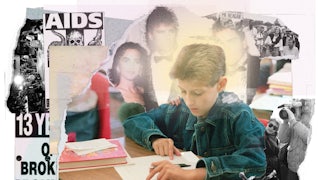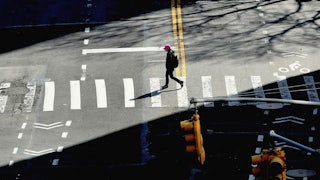One day in 1982 or 1983, a young man in New Haven, Connecticut, learned that his friend had been diagnosed with a medical condition that had only recently acquired the name AIDS. At the time, just a couple dozen people had received such a diagnosis in the entire state of Connecticut. He was stunned. When his friend “was first diagnosed, it was all—I mean, I’d probably heard a little bit about AIDS,” he told me decades later. “But it was still a New York, Greenwich Village thing.”
Such feelings of shock, of This can’t be happening here, were not uncommon in New Haven, a city of about 125,000 abutting the Long Island Sound, probably best known as the home of Yale University. “Especially in the medical profession, there was a reluctance for a long time to think that New Haven was going to be involved significantly in this,” recalled John Dwyer, an immunologist who set up the first AIDS unit at Yale-New Haven Hospital, and who cared for the young man’s friend until his death in mid-1983. “It was supposed to be a San Francisco– and New York–specific tragedy.”
Much like unhappiness in families, the tragedy of AIDS is different in every place that the epidemic has appeared. Over the course of a couple hundred interviews that I conducted over the last decade (for a sadly still embryonic project on the history of AIDS in New Haven), it became clear that, from the epidemic’s earliest days, the transmission of HIV in New Haven arose disproportionately from intravenous drug use, rather than sexual contact. This led to one of the nation’s first, and most systematically studied, syringe exchange programs. Further, the course of the city’s (ongoing) epidemic has been inextricable from New Haven’s proximity to Interstate 95, and from Yale’s parasitic relationship with the town.

Two new books consider the AIDS epidemic in places even further from the major metropolises that have attracted most of the scholarly attention. In AIDS in the Heartland: How Unlikely Coalitions Created a Blueprint for LGBTQ Politics, the historian Katie Batza narrates the early years of the epidemic across the broad middle of the country, focusing especially on Kansas (and, to a lesser extent, St. Louis, Missouri). In From Vice to Nice: Midwestern Politics and the Gentrification of AIDS, the American Studies scholar René Esparza does much the same for the Upper Midwest, paying particular attention to Minneapolis and the effects that AIDS had on that city’s transforming character.
Together, the two books pronounce a paradigm shift in the study of HIV/AIDS. The existing literature largely “fails to explore the heartland,” Batza writes, with even the rare works that venture beyond the coasts remaining confined to “the few major cities that lie in between them.” Indeed, the dominant “historiographical tradition,” continues Esparza, is not only bound to the coasts (or, when in need of a foil, the South) but shackled in particular to “coastal narratives of LGBTQ emancipation.”

A look outside of the nation’s biggest cities reveals histories that are remarkable in their unfamiliarity. In places like Kansas, Batza notes, the spread-out nature of rural living and the relative absence of major hospitals and organized queer networks, meant that people who probably would not have been significantly involved in the response to AIDS in big cities—church van drivers, crop duster pilots, tribal leaders—instead became central players. In the Twin Cities, Esparza writes, queer communities had fewer opportunities to ally with other social movements and thus responded less confrontationally, with gay activists in Minneapolis strategically drawing on their own growing affluence and the idea of “Minnesota nice” to navigate an unprecedented crisis. In both places, according to the two authors, a more obliging approach, one that demanded far less from the state, ultimately had profound—and often devastating—ramifications not just for queer people but for U.S. politics as a whole.
Ironically, the American AIDS epidemic began far from the coastal gay meccas, in St. Louis, Missouri. It was there, in the spring of 1969, that a 16-year-old Black boy named Robert Rayford died, following a series of infections that puzzled his doctors. Even stranger, his autopsy revealed Kaposi’s sarcoma, or K.S., a cancer “nearly unprecedented among Black teenagers,” as Batza notes. Only decades later, in the mid-1980s, would scientists test some of his preserved tissue and discover HIV. The finding astonished the scientific community, essentially setting the timeline of the American epidemic back a full decade, and was extra strange because Rayford had never left the United States, and his Midwestern hometown was far from the major ports through which HIV was likely to enter. “It seems odd to me that it was in St. Louis to begin with,” the chief AIDS epidemiologist for the Centers for Disease Control and Prevention told The New York Times, which noted that AIDS “was first detected in New York and California.”
In all likelihood, HIV circulated among the nation’s poorest inhabitants for years, even decades, before it was detected by the medical establishment. In the 1970s, for instance, homeless people and heroin users began dying of a mysterious condition known colloquially as “junkie pneumonia.” The conventional timeline for the epidemic begins shortly before the July Fourth weekend in 1981, when the Times ran the headline “Rare Cancer Seen in 41 Homosexuals,” famously leading the habitués of Fire Island to spend the holiday weekend examining each other’s bodies for telltale K.S. legions.
For years after that, Batza writes, “the heartland remained unscathed,” even as hospital admissions exploded on the coasts. Indeed, according to Esparza, the “first official case” wasn’t confirmed in the upper Midwest until mid-1982. (New Haven, just a two-hour train ride from New York, started seeing cases a year earlier.) Only in 1983 did Iowa report its first case; as late as 1985, Kansas City had 13 AIDS cases, compared with almost 3,000 in New York City.
On the coasts, activists with deep roots in the queer community swiftly founded new AIDS-specific organizations, such as Gay Men’s Health Crisis (in New York), the San Francisco AIDS Foundation, and AIDS Project Los Angeles. As governmental funding lagged and access to health care remained terminally insecure throughout the 1980s, grassroots collectives emerged to exert pressure on federal authorities and major pharmaceutical companies, most famously via the AIDS Coalition to Unleash Power, or ACT UP. Thousands engaged in civil disobedience, chaining themselves to the New York Stock Exchange, shutting down the Food and Drug Administration, controversially “dying in” at St. Patrick’s Cathedral. In the country’s middle, however, the vast geography and sparse medical infrastructure meant that caregivers had to turn to the home and rely on domestic practices like meal-delivery programs and “buddy” support systems. Esparza calls attention to the “private, everyday caregiving” that is rarely captured in narratives of the epidemic; in small towns across the Midwest, people cared for dying loved ones, discreetly, sometimes even clandestinely. Here was a “quieter history,” writes Batza.
To be sure, there were attempts to start ACT UP chapters in St. Louis, Topeka, Kansas City, and Omaha, but none attracted significant membership and all folded quickly. Their organizers encountered considerable resistance from other heartland AIDS activists, who “were worried about offending people, sensibilities, all that stuff, all that Midwestern stuff,” as one Kansan ACT UP activist recalled. An ACT UP/Minnesota leader quoted by Esparza agreed: “It was hard to get anybody to show up for anything.”
Instead, as Batza writes, activists far from the coasts strategically opted to “piggyback on and transform” existing institutions, rather than create new ones. In Wichita, for instance, the Adorers of the Blood of Christ (a Catholic institute) used one of its buildings as a hospice for AIDS patients, and other Catholic organizations delivered safe-sex kits, including condoms, to Wichita bars, work that Batza notes was “in flagrant noncompliance with Catholic teachings.” In St. Louis, the Trinity Episcopal Church hosted that city’s Efforts for AIDS organization and provided burials for nonparishioners with AIDS, while a coalition of religious organizations funded DOORWAYS, which provided housing for those with AIDS (and was staffed by former and current nuns). According to Batza, “The bulk of the AIDS response infrastructure” in the heartland came from religious organizations.
Of course, individuals also did vital work outside of religious institutions, such as the aging lesbians who operated Topeka AIDS Project, or the managers of a well-known gay bathhouse in Minneapolis who distributed tens of thousands of condoms and hosted safe-sex workshops. Indeed, the rarity of AIDS activists in the region greatly increased their importance. Batza focuses especially on Dr. Donna Sweet, the only AIDS specialist in Kansas, who for a time had five offices spread throughout the state. To this day, Sweet maintains “a caseload of well over 2,000, including every HIV-positive Kansan.”
Throughout the 1980s, prominent chroniclers—desperate to memorialize the lives of loved ones and indict a neglectful system—began constructing the earliest narratives of AIDS. In 1985, for instance, the activist Cleve Jones (born and raised in Indiana, a heartland migrant to San Francisco) came up with the idea for the AIDS Memorial Quilt, a collective art project to commemorate those lost to the epidemic (many of whom had been denied funerals). Among the most important compilers of the epidemic’s history was the San Francisco Chronicle reporter Randy Shilts (another son of the heartland, born in Iowa and raised in Illinois), whose 1987 bestseller And the Band Played On was an authoritative chronology and a powerful exposé of official inaction. The book also “did significant work to conflate the gay community with the coasts and largely ignored even the existence of vast swaths of the country,” Batza writes. Because the most visible work came from the coasts, the rest of the country often appeared to have no place in the story.
In November 1987, Shilts himself arrived in the Twin Cities. He was there to promote his new book, but while in town he took the opportunity to denounce 315 Health Club, Minneapolis’s last gay bathhouse. The fact that it was still open, he told Minnesotans, was “insanity.” He called for its closure—in the name of public health.
Esparza cites this story as an example of a broader campaign by a range of actors, queer and straight alike, to use the AIDS epidemic to effect massive changes to postindustrial Minneapolis and gay life therein. In the 1970s, he writes, before AIDS erupted into the public consciousness, “gay liberationists” and “gay integrationists” in Minnesota struggled fiercely over the direction of the gay rights movement, suddenly formidable in the aftermath of Stonewall. The integrationists sought inclusion within the society around them, no small feat at a time when the American Psychiatric Association still classified homosexuality as a personality disorder, while the liberationists wanted to fundamentally alter society, to radically remake family structures and explode the idea of what was “normal.” In 1974, for instance, the integrationists won an antidiscrimination ordinance in Minneapolis; liberationists fought to have the bill include trans people, but integrationists rebuffed them, believing this would alienate moderate allies. In response, the liberationists formed a coalition with local trans activists and criticized the ordinance for only protecting “straight-looking gays.” At the turn of the 1980s, it was not clear which faction would determine the course of the movement.
The arrival of AIDS “marked a decisive turning point,” Esparza writes, “shattering the stalemate between integrationists and liberationists.” In the face of an unprecedented public health catastrophe, the ethos of liberation—with its orgies and communal sex venues—suddenly struck many, including many queer people, as irresponsible. Perhaps monogamy was safer. The ideal of homeownership—the acquisition of a place in which one could safely, privately have sex, far from the cops or gay-bashers or those of unknown sexual health—flowed naturally from there.
Such a reordering of the gay political agenda coincided with, and accelerated, an ongoing transformation of Minneapolis’s built environment. Throughout the 1970s, city planners and real estate developers sought to eliminate the city’s less reputable establishments, those that might alienate the young professionals that the boosters sought to attract. In the 1980s, AIDS provided the ammunition to turn their visions into reality.
The gay bathhouses were some of their first targets. While an older generation of Minnesota queers had extolled these spaces as community hubs, insurgent integrationists saw them as passé—and as sites of HIV transmission. Liberationists pointed out that authorities ignored singles bars and other places where straights met up for sex, and cited evidence that 315 Health Club, the last of the bathhouses, was not a significant source of infection. But press stories about possible viral transmission (and the publication of And the Band Played On) led Minneapolis’s City Council—including its gay members—to enact an anti-bathhouse ordinance. The owners of 315 Health Club sold to a real estate developer, who was excited about its location in a “trendy redevelopment area” and quickly announced plans to convert it into studio lofts above an upscale restaurant. Meanwhile, the passage of the anti-bathhouse ordinance re-empowered the city’s vice squad, now “cloaked in the language of public health rather than morality,” to raid adult bookstores and arrest patrons for “indecent conduct.” Under the guise of combating AIDS, authorities shut down gay bookstores and X-rated theaters throughout Minneapolis.
The elimination of these spaces “pushed some gay men further into the streets,” Esparza writes, and specifically into Loring Park, infamous as a gay cruising ground. Yet Loring Park was also prime real estate—within walking distance of downtown and a major commercial thoroughfare—and residents (including some gay professionals), eager to boost their property values, found new allies in the police and lobbied City Council for an anti-cruising ordinance. “First it was closing the bathhouses,” one liberationist told a gay publication, “now it’s Loring Park.”
Again, the opponents of public sex cloaked the intervention in the guise of HIV prevention. “This type of sexual activity relates to the spread of AIDS,” one gay male resident of Loring Park told the press. The liberationists counterattacked, creating a group called FAGS (Friends Against Gay Suppression), which organized a “cruise-in” outside the house of the ordinance’s sponsor, and their lobbying succeeded in killing the bill. But they lost the war. By the mid-1990s, upper-middle-class gay homeowners and an enhanced police presence had succeeded in gentrifying Loring Park. Sex workers and unhoused queer people—erstwhile allies of gay liberation—were driven away.
Today, affluent gay couples have joined well-off straight families in occupying condos and brownstones in the most desirable parts of the Twin Cities, orderly neighborhoods replete with bakeries and boutiques. HIV is now treatable—so long as one has money and the kind of employment that guarantees health insurance. “While some gay men and lesbians managed to escape the gay ghetto, both in a literal and figurative sense,” Esparza concludes, “they did so at the cost of leaving others, more marginalized than them, behind.”
The argument is both brilliant and unexpected. While the activist and artist Sarah Schulman has famously argued that AIDS led to the “gentrification of the mind”—the transition from a rebellious queerness to a conservative assimilationism—Esparza argues that the epidemic occasioned gentrification of a much more literal sort. Occasionally, he overreaches—was a Twin Cities realtor really alluding to AIDS when he wrote in a gay publication that the housing market was the “healthiest” it had been in years?—but the connections he draws are genuinely startling.
If his book charts the unintended consequences of AIDS activism in the urban Midwest, Batza does much the same (albeit at less length) for its rural environs. In places like small-town Kansas—unlikely to draw many gay yuppies or much interest from developers—AIDS activists nonetheless strove to make themselves respectable, unthreatening, the better to attract religious allies (and not the wrong kind of attention). For instance, DOORWAYS in St. Louis highlighted the stories of women and children with AIDS, those that might appeal to donors, while de-emphasizing other kinds of patients. When another organization in St. Louis invited a “famous gay stripper and porn actor” to an event, the backlash was sufficient to shutter the group within months. Eager to avoid such a fate, DOORWAYS shied from controversy, or indeed the provision of any services other than housing, an issue that Batza calls “almost uniquely palatable.” The organization was, in the words of one board member, “vanilla.”
This push for palatability, central to what Batza labels the “heartland AIDS response,” proved to be so successful that it “ultimately shaped the national framing of HIV/AIDS and the larger LGBTQ political agenda,” they argue. They see an approach like the one DOORWAYS took in the emphasis that national political organizations placed on issues like marriage and military service in the 1990s and 2000s, and in the focus on privacy rights rather than queer rights, which might demand something from the state other than being left alone. This argument occasionally strays beyond its evidence—were such emphases really the “embracing of heartland ideals,” rather than much older tactics of geographically diverse origins?—but the attention Batza draws to this long-overlooked place and its activists is salutary.
Still, the question remains, only sharpened by reading AIDS in the Heartland and From Vice to Nice in quick succession: Was the epidemic in the country’s middle really so distinct? Religion played a “vastly different role in the heartland AIDS response,” Batza writes, but in New Haven, at least, one of the city’s two most important organizations responding to the early epidemic was the AIDS Interfaith Network, which was created by the leaders of the Immanuel Missionary Baptist Church and started life in the church’s basement. “This is a story that is uniquely upper Midwestern,” Esparza writes, but the “pervasive drive for conformity, moderation, and assimilation” that the region supposedly fosters is arguably the story of the last half-century of gay history, nationwide.
Such an answer, a refutation of Midwestern exceptionalism, is not meant as criticism, however. Rather, Batza and Esparza’s work, viewed together, presents even more intriguing questions: What if New York, San Francisco, and Los Angeles—so long associated with AIDS and with queerness itself—are themselves the outliers? (Certainly, they are today: In 2022 and 2023, a majority of Americans diagnosed with HIV lived in the South.) What if our best-known narratives of AIDS have not merely erased and occluded but misled? And what if the history of the American movement for queer rights, for queerness as liberation, is a history of failure?






